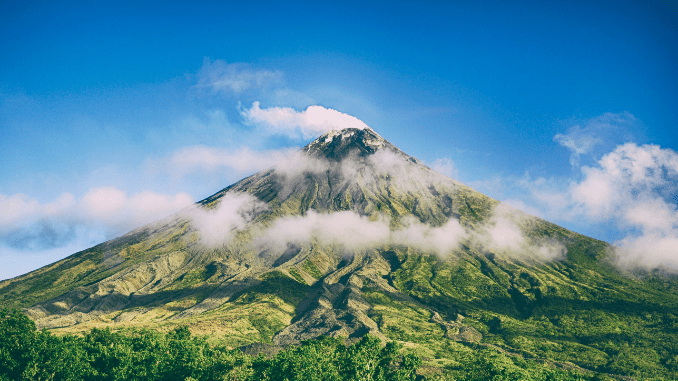
What is a volcano?
A volcano is a mountain or hill from which an abrupt explosion or emission of magma, dust, gas, smoke, and solid materials happens.
Types of volcano
Volcanoes are classified into different types depending on the explosion’s nature and eruption frequency.
Types of volcanoes according to nature of explosion
1. Central eruption type of volcanoes
Materials in this category of volcanoes are ejected through a pipe or vent and come from the surface through a hole. Lava and gases come out with great force and rise in the air to considerable heights.
Example – Hawaii islands
2. Volcanoes of fissure eruption
Such volcanoes do not erupt throughout vents but along fissures, fractures, and faults. The magma comes out slowly over the surface and spreads to far distances.
Example – Columbian Plateau of U.S.A
3. Mud volcanoes
These volcanoes are found in petroleum and gas-producing areas.
Example – Boga Boga near Baku oil field, Azerbaijan.
Types of volcanoes according to their frequency
1. Active volcanoes
These volcanoes keep on ejecting volcanic material at frequent intervals.
Example – Etna volcano, Italy.
2. Dormant volcanoes
The dormant volcanoes are those in which an eruption has not occurred regularly for a long time. But they cause great damage to life and property.
Example – Vesuvius volcano of Italy has exploded only 10 times in about 1500 years.
3. Extinct volcanoes
The volcanoes which have not recorded any eruption in historic times are called extinct volcanoes.
Example – Popa volcanoes, Myanmar.
What are volcanic landforms?
Numerous types of landforms are created due to the cooling and solidification of magma below and above the earth’s surface. Let us discuss a few types of volcanic landforms.
Types of volcanic landforms
1. Lava plateau
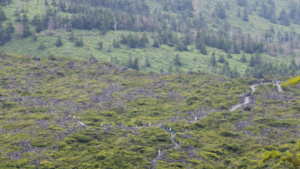
- When more fluid lava with low silica content comes out of a volcano, it spreads to great distance and covers a vast area with thick sheets of lava. lava plateaus are formed.
- They are flattened, elevated regions.
- They are of high altitude.
- Lava plateaus are rich in mineral deposits.
Example
- Garron plateau, Northern Ireland.
- Columbian plateau, North America
- Deccan plateau, India
2. Lava mesa
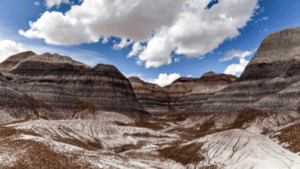
- It is an isolated high plateau with a flat top and steep slides
- They are formed by weathering and erosion of horizontally layered rocks that have been uplifted by tectonic activity.
- They are a common sight in volcanic regions.
- When lava cools and solidifies, it forms a hard cap on top of soft erodible material.
- With time, the softcover erodes and leaves the mesas behind.
Example
- Cockburn range, West Australia
- Masada, Southern District, Israel
- Anderson Mesa,Arizona,U.S.A
3. Volcanic neck with radiating dykes
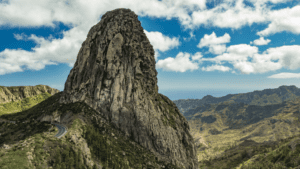
- These are wall-like sheets of lava which radiate away from the central neck of the volcano.
- They are formed in a fracture of a pre-existing rock body.
- When magma solidifies within a vent of a volcano, it forms a hard, resistant body called volcanic neck.
- Dykes, or dikes are vertical or near-vertical sheets of igneous rock that cut across the surrounding rock layers.
Example
- Lord Howe Island,Australia
- Baranof Island,Alaska
- West Spanish Peak,Colorado,U.S.A
4. Caldera

- Caldera is a large roughly circular volcanic depression often several hundred kilometers in area.
- Caldera usually has a number of smaller vents and can also contain a large crater lake.
- Calderas are formed in a variety of ways.
- The most accepted mechanism is the collapse or subsidence which may relate to explosive eruptions.
- The largest caldera in the world is in Japan which is 27 km/16 km.
Example
- Yellowstone park, U.S.A
- La Pacana, Chile
- Cerro Galan, Argentina
5. Ash cone or Cinder cone
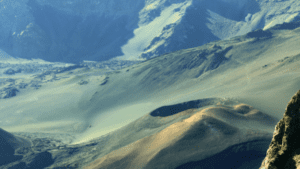
- The volcanic material thrown out by a volcano cools down quickly in small solid pieces known as cinder.
- Solid particles are rained down and form a circular cone around the crater.
- Known as a cinder or ash cone.
- The cinder cone is formed after a number of explosions.
- Average height of an ash cone is about 30 meters and has concave slopes.
- They are termed central types of volcanoes because eruption takes place through a central hole in the crust connected with the interior through a vertical pipe.
Example
- Dragon cone, North America
- Mount Elephant, Australia
- Central volcanic zone, Peru, South America.
- Volcanic dome:-
- This cone is also known as an acid lava cone.
- It is formed by acid lava which is vicious and has the dominance of silica.
- This lava deposits itself near the neck immediately after the explosion.
- It forms a dome-like structure after solidification.
Example
- Pary-de-dome,France
- Lessen Peak, California
- Santa Maria lava dome, Guatemala
Q&A
-
What are volcanic landforms?
Landforms created due to the cooling and solidification of magmas below the earth’s surface and lavas over the earth’s surface give rise to volcanic landforms.
-
What are the basic landforms of lava?
The basic landforms created from lava are-
- Volcanoes
- Domes
- Lava plateaus
- Calderas
-
What is the largest type of volcanic landform?
The largest volcanic landforms are lava plateaus. Are spread over miles and miles of land. An example are Deccan plateau in India is one of the largest volcanic features on Earth.
-
What are some interesting facts about volcanic landforms?
Some interesting facts about volcanic landforms are-
- The word volcano comes from the Roman name “Vulcan” who was the Roman god of fire.
- Approximately 350 million people live within the danger range of an active volcano
- Volcanoes and volcanic landforms are present throughout the solar system.
Summary
- Volcanoes are geological formations resulting from the eruption of magma from the earth’s mantle to the surface.
- Ejection of Magma, steam, dust, smoke, and pyroclastic materials happens during the eruption.
- There are various types of volcanoes based on their occurrence and nature.
- Dormant volcanoes, extinct volcanoes, and mud volcanoes are a few examples of types of volcanoes.
- When lava cools down and solidifies it forms various types of volcanic landforms.
- Lava plateaus, cinder cones, dykes, etc are some volcanic landforms.
- The major areas in the world where the majority of volcanoes erupt are the borders of the Pacific Ocean, the Mid-World belt, The African Rift Valley, etc.
References
- Binay Karna. Lucents general knowledge.Lucent publication, Patna.Chapter 04-Geography, Page no:128-129.
- D.R.Khullar.ISC Geography.Kalyani Publishers, Kolkata.Chapter 08-Volcanoes and earthquakes, Page no-120-149.
- Savindra Singh.Geomorphology.Pravalika Publications Allahabad.Chapter 12-Vulcanicity and landforms,Page no-200-215.
